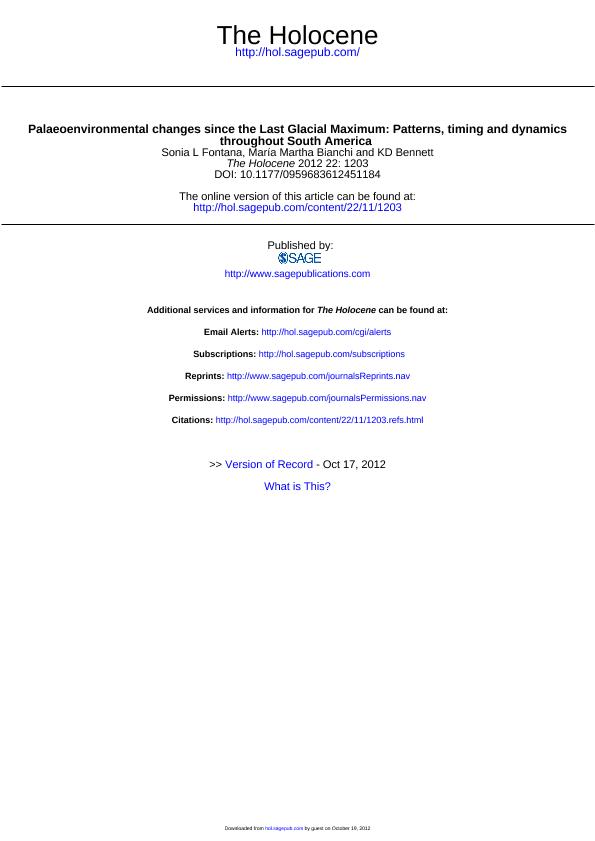Mostrar el registro sencillo del ítem
dc.contributor.author
Fontana, Sonia L.
dc.contributor.author
Bianchi, Maria Martha

dc.contributor.author
Bennett, K. D.
dc.date.available
2023-04-20T17:16:48Z
dc.date.issued
2012-11
dc.identifier.citation
Fontana, Sonia L.; Bianchi, Maria Martha; Bennett, K. D.; Palaeoenvironmental changes since the Last Glacial Maximum: patterns, timing and dynamics throughout South America; Sage Publications Ltd; Holocene (Seven Oaks); 22; 11; 11-2012; 1203-1206
dc.identifier.issn
0959-6836
dc.identifier.uri
http://hdl.handle.net/11336/194784
dc.description.abstract
The vast diversity of present vegetation and environments that occur throughout South America (12°N to 56°S) is the result of diverse processes that have been operating and interacting at different spatial and temporal scales. Global factors, such as the concentration of CO2 in the atmosphere, may have been significant for high altitude vegetation during times of lower abundance, while lower sea levels of glacial stages potentially opened areas of continental shelf for colonisation during a substantial portion of the Quaternary. Latitudinal variation in orbital forcing has operated on a regional scale. The pace of climate change in the tropics is dominated by precessional oscillations of c. 20 kyr, while the high latitudes of the south are dominated by obliquity oscillations of c. 40 kyr. In particular, seasonal insolation changes forced by precessional oscillations must have had important consequences for the distribution limits of species, with potentially different effects depending on the latitude. The availability of taxa, altitude and human impact, among other events, have locally influenced the environments. Disentangling the different forcing factors of environmental change that operate on different timescales, and understanding the underlying mechanisms leads to considerable challenges for palaeoecologists. The papers in this Special Issue present a selection of palaeoecological studies throughout South America on vegetation changes and other aspects of the environment, providing a window on the possible complexity of the nature of transitions and timings that are potentially available.
dc.format
application/pdf
dc.language.iso
eng
dc.publisher
Sage Publications Ltd

dc.rights
info:eu-repo/semantics/openAccess
dc.rights.uri
https://creativecommons.org/licenses/by-nc-sa/2.5/ar/
dc.subject
CLIMATE CHANGE
dc.subject
HOLOCENE
dc.subject
PALAEOECOLOGY
dc.subject
QUATERNARY
dc.subject
SOUTH AMERICA
dc.subject
VEGETATION
dc.subject.classification
Geociencias multidisciplinaria

dc.subject.classification
Ciencias de la Tierra y relacionadas con el Medio Ambiente

dc.subject.classification
CIENCIAS NATURALES Y EXACTAS

dc.title
Palaeoenvironmental changes since the Last Glacial Maximum: patterns, timing and dynamics throughout South America
dc.type
info:eu-repo/semantics/article
dc.type
info:ar-repo/semantics/artículo
dc.type
info:eu-repo/semantics/publishedVersion
dc.date.updated
2023-04-19T15:27:03Z
dc.journal.volume
22
dc.journal.number
11
dc.journal.pagination
1203-1206
dc.journal.pais
Estados Unidos

dc.description.fil
Fil: Fontana, Sonia L.. The Queens University of Belfast; Irlanda
dc.description.fil
Fil: Bianchi, Maria Martha. Secretaría de Cultura de la Nación. Dirección Nacional de Cultura y Museos. Instituto Nacional de Antropología y Pensamiento Latinoamericano; Argentina. Consejo Nacional de Investigaciones Científicas y Técnicas; Argentina
dc.description.fil
Fil: Bennett, K. D.. The Queens University of Belfast; Irlanda
dc.journal.title
Holocene (Seven Oaks)

dc.relation.alternativeid
info:eu-repo/semantics/altIdentifier/url/https://journals.sagepub.com/doi/10.1177/0959683612451184
dc.relation.alternativeid
info:eu-repo/semantics/altIdentifier/doi/http://dx.doi.org/10.1177/0959683612451184
Archivos asociados
